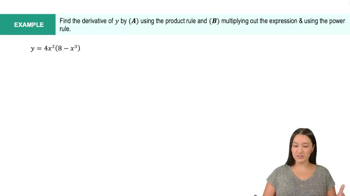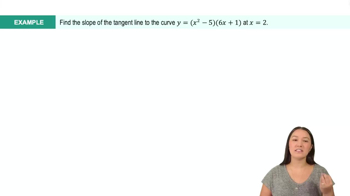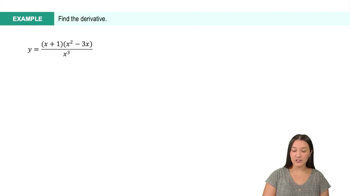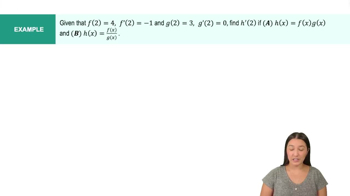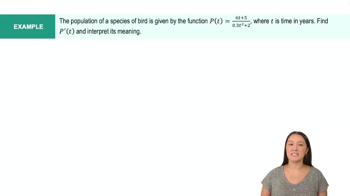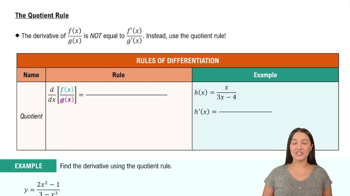Table of contents
- 0. Functions7h 52m
- Introduction to Functions16m
- Piecewise Functions10m
- Properties of Functions9m
- Common Functions1h 8m
- Transformations5m
- Combining Functions27m
- Exponent rules32m
- Exponential Functions28m
- Logarithmic Functions24m
- Properties of Logarithms34m
- Exponential & Logarithmic Equations35m
- Introduction to Trigonometric Functions38m
- Graphs of Trigonometric Functions44m
- Trigonometric Identities47m
- Inverse Trigonometric Functions48m
- 1. Limits and Continuity2h 2m
- 2. Intro to Derivatives1h 33m
- 3. Techniques of Differentiation3h 18m
- 4. Applications of Derivatives2h 38m
- 5. Graphical Applications of Derivatives6h 2m
- 6. Derivatives of Inverse, Exponential, & Logarithmic Functions2h 37m
- 7. Antiderivatives & Indefinite Integrals1h 26m
- 8. Definite Integrals4h 44m
- 9. Graphical Applications of Integrals2h 27m
- 10. Physics Applications of Integrals 2h 22m
3. Techniques of Differentiation
Product and Quotient Rules
Problem 3.4.36
Textbook Question
Find and simplify the derivative of the following functions.
f(x) = ex(x3 − 3x2 + 6x − 6)
 Verified step by step guidance
Verified step by step guidance1
Step 1: Identify the function f(x) = e^x (x^3 - 3x^2 + 6x - 6) as a product of two functions: u(x) = e^x and v(x) = x^3 - 3x^2 + 6x - 6.
Step 2: Use the product rule for differentiation, which states that if you have a function h(x) = u(x)v(x), then the derivative h'(x) = u'(x)v(x) + u(x)v'(x).
Step 3: Differentiate u(x) = e^x. The derivative u'(x) = e^x, since the derivative of e^x with respect to x is e^x.
Step 4: Differentiate v(x) = x^3 - 3x^2 + 6x - 6. Use the power rule for each term: v'(x) = 3x^2 - 6x + 6.
Step 5: Substitute u(x), u'(x), v(x), and v'(x) into the product rule formula: f'(x) = e^x (3x^2 - 6x + 6) + e^x (x^3 - 3x^2 + 6x - 6). Simplify the expression by factoring out e^x.
 Verified video answer for a similar problem:
Verified video answer for a similar problem:This video solution was recommended by our tutors as helpful for the problem above
Video duration:
4mPlay a video:
Was this helpful?
Key Concepts
Here are the essential concepts you must grasp in order to answer the question correctly.
Derivative
The derivative of a function measures how the function's output value changes as its input value changes. It is defined as the limit of the average rate of change of the function over an interval as the interval approaches zero. In calculus, the derivative is often denoted as f'(x) or df/dx, and it provides critical information about the function's behavior, such as its slope and points of tangency.
Recommended video:

Derivatives
Product Rule
The product rule is a formula used to find the derivative of the product of two functions. If u(x) and v(x) are two differentiable functions, the product rule states that the derivative of their product is given by u'v + uv'. This rule is essential when differentiating functions that are products of simpler functions, such as the function f(x) in the given question.
Recommended video:
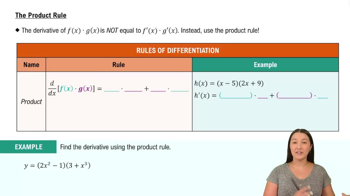
The Product Rule
Exponential Function
An exponential function is a mathematical function of the form f(x) = a * e^(bx), where e is Euler's number (approximately 2.71828), and a and b are constants. The derivative of an exponential function is unique because it is proportional to the function itself, meaning that d/dx[e^(bx)] = b * e^(bx). Understanding the properties of exponential functions is crucial for simplifying derivatives involving them, as seen in the function f(x) provided.
Recommended video:
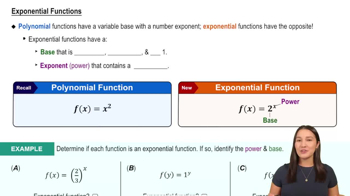
Exponential Functions
Related Videos
Related Practice



